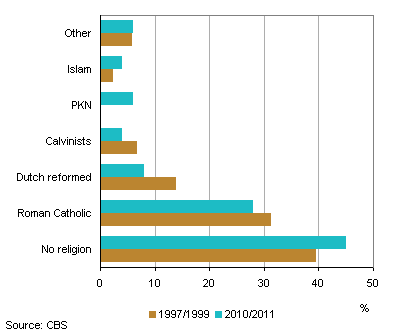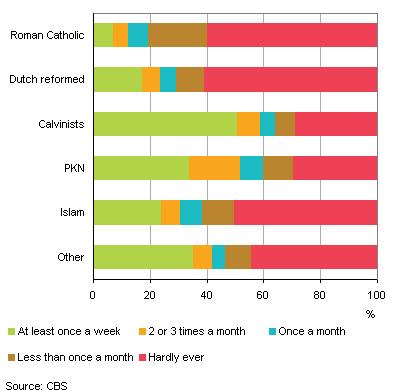One in six go to church or mosque on a regular basis

More than half of the Dutch population aged 18 years and older state they are members of a denomination or ideological group. In the period 2010-2011, one in six regularly attended religious services in a church or mosque or went to other religious meetings. In prior years, the attendance rates were higher.
Nearly 30 percent are Roman Catholics
In the adult Dutch population, 55 percent are religious. With 28 percent, Roman Catholics constitute the largest group; 8 percent are Dutch reformed, 4 percent are Calvinists, 6 percent belong to the Protestant Church in the Netherlands (PKN), 4 percent are Muslims and 6 percent, among whom Hindus nearly (1 percent) and Buddhists (0.5 percent) belong to other religious denominations or ideological groups. In the period 2010-2011, the number of religious people has declined by 3 percentage points relative to the period 2004-2008.
Population aged 18 years and older by religious denomination

Calvinists are most loyal churchgoers
One in three in the small majority (55 percent) of people belonging to religious denominations regularly go to a church or mosque. The attendance rate of religious services varies considerably from one denomination to another. Calvinists are the most loyal worshippers: 64 percent go to church at least once a month, followed by PKN members with 60 percent. With 29 percent, the attendance rate is significantly lower among Dutch reformed and the Roman Catholic Church attendance rate is only 19 percent. The rates for religious service attendance are even lower for Hindus and Buddhists (18 and 13 percent respectively). With 38 percent, the rate for Muslims is above average.
Church and mosque attendance by denomination, 2010/2011

Three quarters hardly ever attend religious services
The amount of people who go to churches, mosques and other religious meetings has declined significantly; two thirds hardly ever attended religious services in 1997-1999 versus three quarters in 2010-2011. Seventeen percent attend religious services at least once a month, a reduction by 7 percentage points relative to 1997-1999.
The decline is very obvious among older people; from 33 to 17 percent in the 55 to 64-year population and from 39 to 25 percent in the 65-74 age group. The decline is barely noticeable among people aged between 18 and 34. With 13 percent, the attendance level in this age category is already low.
The downward trend is observed across the board and applies to all levels of education, both genders and people with a native Dutch background and a foreign background.
Hans Schmeets